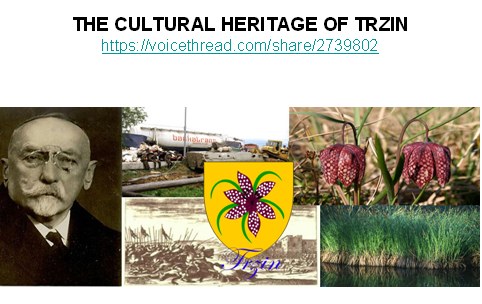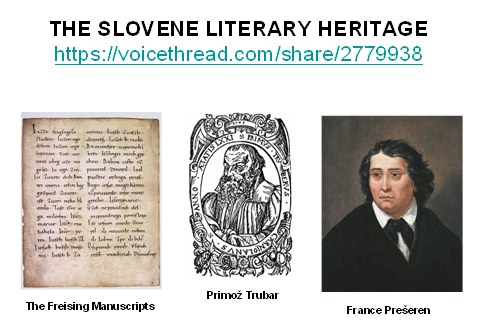Developing Intercultural Communication and Teaching Culture by the Use of VoiceThread in Primary School
Stanislava Jaklic, Slovenia
Stanislava Jaklic has been teaching English at Primary School Trzin, Slovenia for twenty-eight years. Her interests include integrating culture, cross-cultural communication and ICT into language teaching and learning.E-mail: stanka.jaklic@guest.arnes.si
Menu
Introduction
Developing (inter)cultural dimension in language teaching
Project-work learning
VoiceThread
Across cultures
Guest speakers
Conclusion
In today faster than ever changing society teachers are faced with a challenge how to adapt to change in the field of methodology as well as technology in teaching and learning processes. Equally, the twenty-first century learners require greater challenges, more variety and flexibility in their learning. Some of the basic objectives in the updated national and foreign language curricula in Slovene primary school are to enable pupils to develop awareness of belonging to the nation, national identity and cultural heritage, and to nurture cultural values. These objectives and aims can be achieved by integrating culture and cultural heritage into language learning. There are many different ways, strategies and techniques to teach culture. By using a combination of visual, audio and tactile materials, we are likely to succeed in addressing the different learning styles of our students. The use of information technology can be one of the ways to teach culture. The article provides a useful example of how to integrate language teaching, ICT and cultural awareness.
Knowledge of the world's languages and cultures is more vital than ever. In order to compete in the global community, we must be able to communicate effectively. It means that speaking “good English” is not good enough any more. We have to appreciate, understand, and be able to work in the framework of other cultures.
Since language (linguistic) competence, good knowledge of language as a communication tool does not guarantee success in intercultural communication, integrating intercultural dimension should be an essential part of language learning at all levels of education. According to Byram (2002) the aims of developing the intercultural dimension in language teaching are: to give learners intercultural as well as linguistic competence; to prepare them for interaction with people of other cultures; to enable them to understand and accept people from other cultures as individuals with other distinctive perspectives, values and behaviours, and to help them to see that such interaction is an enriching experience.
Dignen (2011) claims you need to be able to do three things to communicate effectively and successfully across cultures:
- You need to have an understanding of your own culture and the target culture you are dealing with. This means researching and analysing the national, regional and corporate cultures of the people you are dealing with.
- You need to be flexible in the way you communicate with people from other cultures. This means adapting your style of communication to fit the situation.
- You need to develop an international style of communication that will enable you to get your message across effectively in all situations.
There has been a tendency of the Council of Europe language policy to develop the intercultural dimension in language teaching and to use intercultural and communicative approach to teaching language. According to CEFR (1996) one of the aims specified in The Common European Framework of Reference for Languages is to ensure that students achieve a wider and deeper understanding of the way of life and forms of thought of other peoples and their cultural heritage. Some of the basic objectives in the updated national and foreign language curricula in Slovene primary school are to enable pupils to develop awareness of belonging to the nation, national identity and cultural heritage; to develop respect for human rights, tolerance and acceptance of diversity and to nurture cultural values; to get involved in the Slovene, European and world community of nations and nationalities on the basis of mutual respect and intercultural communication.
In the light of these aims and objectives, teachers of English at all levels of education - primary, secondary and tertiary - play an important and a valuable role in raising students' (inter)cultural awareness and in developing intercultural communication. Most teachers of English as a second/foreign language would agree that our job is not just to teach language and develop linguistic skills (i.e. writing, reading, listening and speaking; grammar rules and vocabulary), but also to teach culture and develop students' (inter)cultural awareness. It is not a problem to accept this dual role, the complication lies in choosing the content, it is not easy to determine what to teach and include in our lessons. In my opinion, students should be, first of all, aware of their own culture, only then can they compare and contrast their own culture with cultures of other countries, not just English-speaking countries, but cultures of all European and also other countries in the world. That is why I decided to do the project work on cultural heritage of my students’ home town. I wanted to approach this topic closer to my students, and above all, prepare them to be able to present their home town and its cultural heritage to foreigners in English.
Newbold and Hutchinson (2005) say that project work provides learning from students own experience and captures better than any other activity the three principal elements of a communicative approach: a concern for motivation, a concern for relevance and a concern for the general educational development of the learner. Positive motivation is the key to successful language learning and project work is particularly useful as a means of generating this. Firstly, project work is very personal (my students wrote about their town Trzin). Secondly, project work is a very active medium (the students collected information of Trzin, took photos, arranged texts and illustrations, carried out interviews and made recordings). Lastly, project work gives a clear sense of achievement. It enables students to produce a worthwhile product. One of the most important features of project work is presentation. Public display gives students an added incentive to do their best work.The main aim of the project work was to encourage students to use their foreign language knowledge in practice and to show them that English is not just to talk about the ways of English-speaking world. It is also a means for learners to tell the world about their own culture.

There are many different ways, strategies and techniques to teach culture and cultural heritage. Some possible sources of information which can be used as materials for teaching culture are: video, CDs, TV, readings, the internet, stories and story-telling, songs, films, newspapers, interviews, guest speakers, anecdotes, souvenirs, photographs, surveys, literature etc.
The twenty-first century young learner is digitally literate, experimental and social; he/she is good at reading visual images, craves interactivity, likes to learn through exploration, learns through digital media and uses computers more than books. That is why I decided to use VoiceThread to present the project on cultural heritage of my students’ hometown.
VoiceThread is a free online tool to use in the classroom, it is a cloud based application that allows you to upload many different types of media and have conversations around the media whether it is images, videos, documents or presentations or any combinations of them. “The Cultural Heritage of Trzin” is a VoiceThread project, prepared by 8-graders, in which they present the coat-of-arms and the flag of the municipality of Trzin, some historical facts, the places of interest, the oldest buildings, famous people, folk customs and songs, autochthonous food, plants and traditional events. The project can be seen at https://voicethread.com/share/2739802

The second VoiceThread Project “The Slovene Literature Heritage”, prepared by 9-graders, presents the three great miracles of the Slovene Literary Heritage: the Freising Manuscripts, which represent the earliest texts in the Slovene language; Primoz Trubar, the founding father of Slovene literature, who published the first Slovene books – Catechismus and Abecedarium – in 1550; and France Preseren, the Slovene greatest poet. Both VoiceThreads are examples of content language integrated learning and cross-curricular links. The VoiceThread project on The Slovene Literary Heritage can be seen at: https://voicethread.com/share/2779938.

Across Cultures is a reference book which I often use for developing intercultural communication in my teaching practice. It is a book about Slovene-British-American intercultural communication, written by Nada Sabec and David Limon (2001). In the first part there are different speech acts such as introductions and greetings, invitations, compliments, complaints and apologies as well as other conversational strategies and aspects of non-verbal communication. The second part focuses on broader cultural and social issues such as the concept of time and space, family values, personal relationships, work ethic, common beliefs and superstitions, holidays and festivities, eating and drinking habits etc. The book concludes with a chapter on culture shock, based on personal experiences of English speakers who have lived and worked in Slovenia, as well as Slovenes who have had a similar experience in Britain and the States. It is a very useful book which I often use as an appendix to the textbook for extending and upgrading the culture pages in classroom.
One of the ways to bring culture into classroom is 'guest speakers'. Last year our school took part in the U.S. Embassy Speaker Programme which offers schools the chance to hear from Americans first-hand on the topics of interest. The U.S. Embassy introduced this programme to give teachers and students the possibility to meet and talk to diplomats of the U.S. Embassy in Ljubljana. The speakers present a short overview of a particular subject relating to American society - e.g. popular culture, the educational system, domestic politics, daily life as well as issues pertaining to international affairs, or talk more generally about their lives - their jobs, the schools and universities they attended, their hometowns and then open the floor to discussion and questions. Last year in May U.S. Embassy diplomat Mrs Susan Wilson enjoyed the hospitality of Primary School Trzin. The students prepared a welcome programme for our guest speaker that included the school’s introduction and some music. She introduced the United States of America, explained what the U.S. Embassy in Slovenia does, and told some anecdotes about schooling and being an American teenager. She had a very didactic power-point presentation about her home town in Richmond, Virginia. After her presentation students had the opportunity to ask questions which ranged from personal questions to questions about the United States of America. It was a very nice cultural experience for both students and teachers.
Teaching culture as well as developing intercultural communication is an essential part of language learning and, in my opinion, should be systematically incorporated into second language curricula and textbooks. By integrating culturally-oriented activities in classroom, students develop awareness of belonging to the nation, national identity and cultural heritage. The use of ICT – VoiceThread provides a wonderful opportunity for student self expression and creativity. The project on cultural heritage turned out to be a useful contribution to a largely neglected field of language teaching and learning in Slovene primary schools. I think the emphasis is still much more on teaching grammar and lexis than on teaching culture. The teachers’ role is to find the most effective ways to integrate culture and its dimensions into language teaching to avoid students’ misunderstandings and cultural shock when going on international exchange visits.
M. Byram, B. Gribkova, and H. Starkey, “Developing the Intercultural Dimension in Language Teaching,” Council of Europe, Strasbourg, 2002, pp. 3-10,
B. Dignen, “Communicating Across Cultures,” Cambridge University Press, Cambridge, 2011, p 4.
Council of Europe, “The Common European Framework of Reference for Languages: Learning, teaching, Assessment,” Cambridge University Press, Cambridge, 1996, pp 2-4.
N. Sabec, D. Limon, “Across cultures,” Zalozba Obzorja, 2001, pp 11-13.
D. Newbold, T. Hutchinson, “Project 4,” Oxford University Press, 2005, pp 8-9.

Please check the British Life, Language and Culture course at Pilgrims website.
Please check the ICT - Using Technology in the Classroom – Level 1 course at Pilgrims website.
Please check the ICT - Using Technology in the Classroom – Level 2 course at Pilgrims website.


|